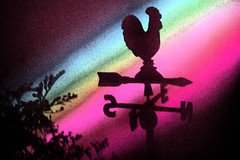
Unless you actually possess one, a weathervane is something that many of us see most days but don’t necessarily take much notice of. We all go about our business and probably take for granted the weathervanes that are situated all around us; perhaps at work or in our own neighbourhood - possibly even next door.
The weathervane comes in all shapes and sizes and can be found in any manner of places, most commonly upon rooftops. They usually are made of either copper or aluminium and can represent anything from mythical creatures to household animals - for example: gargoyles; angels; dragons, geese, eagles, herons, humming birds, dogs, cows, bears, prancing horses and possibly the most familiar of all - the rooster!
The rooster became an immortalised sculpture upon the tops of domes in all the world of Christendom, when the pope proclaimed that in honour of the apostle Peter, each church should have a rooster on the rooftops as weathervanes, to act as a constant reminder to followers of peace and harmony, like that of times gone by. Rooftop mounted wrought iron weathervanes bring about the feeling of old world charm that can be imparted onto a house, garage or barn.

By definition weathervanes, or weathercocks as they are also called, are figures that turns freely on a vertical rod and by virtue of their design, always points into the wind. Stated another way, the wind always comes from the direction in which the weathervane points. For centuries mankind has realised that wind direction was is the near certain indicator of weather patterns and farmers relied heavily on the object stuck up on their outhouse roof. Their livelihoods were often driven by the information ascertained from the weathervane.
As years have passed, the creative art form has become as important as the functionality. For this reason weathervanes sculptures are now highly sought after, with many fetching great sums of money; often as much as five figures!
From : weathervane-or-shine
Tidak ada komentar:
Posting Komentar